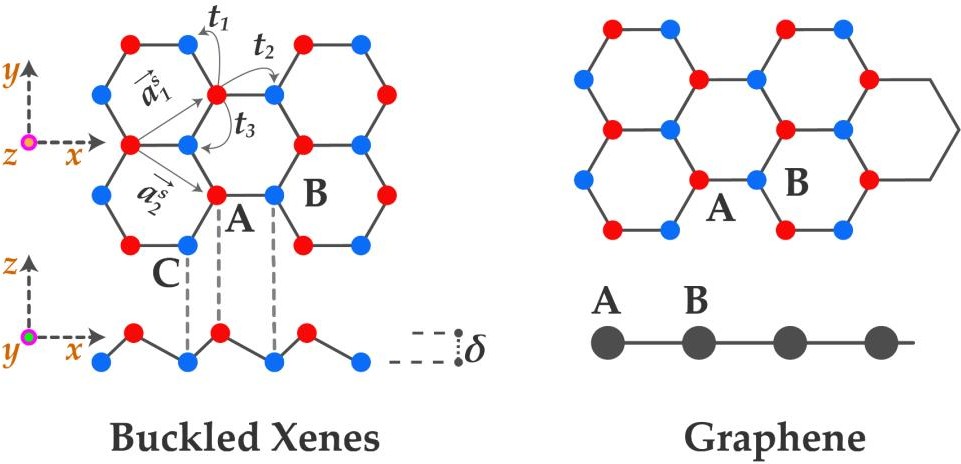Scientists theoretically probe the atomic properties of the 2D materials under strain

Graphene, a 2-dimensional (2D) sheet made of a single layer of carbon atoms, is a wonder material with remarkable electrical, mechanical, and chemical characteristics. Its properties make it ideal for a diverse set of applications spanning various industries. The discovery soon led to the development of a host of other 2D materials, collectively called X-enes or just Xenes. Here, the X can be an element, from group IV of the periodic table such as silicon, germanium, and tin, that has 2D counterparts called silicene, germanene, and stanene, (from the Latin name for tin -stannum). Atomically, the Xenes share a lot of the characteristics of graphene, but add more features, making them candidates for use in modern digital infrastructure.
While graphene is formed by a flat sheet of carbon atoms in a single plane, the atoms of many other 2D materials arrange themselves in a zig-zag or chainsaw (As in figure) pattern earning them the name ‘buckled Xenes’. “The degree of buckling can detect the electronic character or influence the chemical reactivity. So, buckling can foster a number of potential functionalities that can be readily engineered,” explains Mr. Swastik Sahoo, a doctoral student at the Department of Electrical Engineering at the Indian Institute of Technology, Bombay (IIT Bombay).

As a new entrant into the world of material science, the properties of buckled Xenes are still being investigated. In a first, Mr. Sahoo and the team consisting of researchers from IIT Bombay and India Korea Science and Technology Center (IKST), Bengaluru, led by Prof. Bhaskaran Muralidharan, a Professor at the Department of Electrical Engineering, IIT Bombay, used theoretical analyses to predict the properties of buckled Xenes. They used well-known but complementary quantum theories - Density Functional Theory (DFT) and Quantum Transport theories to probe the material at an atomic level, to determine the electrical properties of these materials, especially when strain is applied to them. DFT is a quantum mechanical model that allows us to study the properties of many-electron systems, like atoms with multiple electrons in orbit, while quantum transport theory explains how the particles within an atom move across the device structure as a voltage is applied, thus probing its electrical properties.
According to Prof. Muralidharan, “DFT has strong predictive power, even for completely new molecules or materials. DFT calculations are used to help understand how materials and devices behave and operate under different conditions.” The DFT calculations were done in collaboration with IKST Bengaluru with the R & D Head Dr. Satadeep Bhattacharjee as the lead. The researchers used DFT to understand the behaviour of the buckled Xenes under different strain conditions. Next, quantum transport theory was employed to understand the change in the electronic properties of the material under different conditions, like increasing the application of strain. “Quantum transport theory is based on the Landauer approach, which is a simple, physical approach to analyse electron transport at nanoscale. The Landauer formula is a valuable tool for calculating current-voltage characteristics,” he adds.
Using these quantum principles, the team studied how strain applied to buckled Xenes affected the properties of the material, particularly, a property called directional piezoresistance. Piezoresistance is a property of materials wherein strain applied to the material changes the electrical resistance of the material. The study reports that 2D-Xene materials exhibit robust stability under strain, meaning they keep their electrical and mechanical performance at high-levels when bent, stretched or twisted - all important qualities for the development of flexible electronics, like wearables and smartphones.
The team focused on silicene - a single layer of silicon atoms - and compared it to other materials in the Xene family, such as germanene, stanene, and phosphorene. “Silicene is a prime contender for various applications due to its consonance with the already certified silicon industry,” remarks Mr. Sahoo. From their study, the researchers at IIT Bombay have deduced the transport angles for 2D Xenes, which is the critical angle at which the electrical properties of the 2D Xene remain stable. Stanene is especially notable, maintaining stability even when strain up to 10% is applied. Interestingly, they report that the changes corresponding to changing strain levels follow a sinusoidal pattern, a characteristic that might help engineers design smart devices, like folding smartphones and smart screens, that react predictably to twisting and bending.
Looking ahead, the scientists plan to further explore the capabilities of buckled Xenes, particularly focusing on their interactions with spintronics (a study of the effects of the intrinsic spin of electrons on semiconductors) and the effects of strain on the interface between buckled Xenes and metal substrates.
The researchers anticipate that the versatility and stability of buckled Xenes will pave the way for significant advancements in various industries. The study could open doors to a world of high-performance, flexible electronics. Buckled Xenes offer exciting new possibilities for applications such as roll-up computers, wearable technology, and advanced quantum devices, promising a future defined by unparalleled flexibility and efficiency in electronics.
|
Article written by: |
Dennis Joy |
|
Image/ Graphics credit: |
|
|
Gubbi Labs Link: |
|
